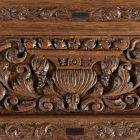
Two-storey cabinet with four doors - Beeldenkast
| Accession Nr.: | 5994 |
|---|---|
| Date of production: |
first half of the 17th century
|
| Place of production: | Netherlands |
With the Union of Utrecht (1579), Holland to all intents and purposes split from Flanders. The seven Northern provinces chose William of Orange (1533–1584) as their governor. In 1609, Holland achieved its independence, in 1648 winning recognition of that independence and setting out on the road to modernisation. By means of its trade, it became Europe’s leading maritime and financial power. Amsterdam soon took over from Antwerp the leading role in the direction of artistic life. In contrast to Flemish aristocratic luxury furniture, Dutch furniture was simpler, plainer and more middle class. In Holland attachment to traditional, old furniture types was strong. Chests were favoured, as were low and two-level cabinets, sideboards and versions of these. The fine example of the four-door, two-level cabinet preserved in Budapest according most of all with the requirements of a middle-class home is carved from hard oak. On its front side we can discover an entire storehouse of motifs of the Dutch late Renaissance inclining to the baroque: birds hiding among tangled creeper, vases of flowers conveying the atmosphere of still lifes, bunches of grapes concealed among leafy stalks, horn-blowing tritons standing on seashells, animal claws, and heads of lions with thick manes on projecting brackets. We encounter this two-level, four-door type of cabinet in many museums in Germany, e.g. in Weimar, but also in the one-time castle of the Palffy counts at Voroskő castle (today Červeny Kameň, Furniture Museum of East Slovakia).
Literature
- Szerk.: Radványi Orsolya, Németh István: El Grecótól Rippl-Rónaiig, Nemes Marcell, a mecénás műgyűjtő. Szépművészeti Múzeum, Budapest, 2011. - Nr. 104.
- Szerk.: Horváth Hilda, Szilágyi András: Remekművek az Iparművészeti Múzeum gyűjteményéből. (Kézirat). Iparművészeti Múzeum, Budapest, 2010. - Nr. 52. (Vadászi Erzsébet)
- Batári Ferenc, Vadászi Erzsébet: Bútorművészet a gótikától a biedermeierig. Iparművészeti Múzeum, Budapest, 2000. - 39, (Nr. 4.)
- Szerk.: Lovag Zsuzsa: Az Iparművészeti Múzeum. (kézirat). Iparművészeti Múzeum, Budapest, 1994. - Nr. 26.
- Szerk.: Péter Márta: Reneszánsz és manierizmus. Az európai iparművészet korszakai. Iparművészeti Múzeum, Budapest, 1988. - Nr. 293. (Vadászi Erzsébet)
- Szerk.: Voit Pál, László Emőke: Régiségek könyve. Gondolat Kiadó, Budapest, 1983. - p. 32., 25. kép
- Szerk.: Radocsay Dénes, Farkas Zsuzsanna: Az európai iparművészet remekei. Száz éves az Iparművészeti Múzeum 1872-1972. Iparművészeti Múzeum, Budapest, 1972. - Nr. 152.
- Szerk.: Csányi Károly: Az Országos Magyar Iparművészeti Múzeum gyűjteményei - az iparművészet rövid történetével. Iparművészeti Múzeum, Budapest, 1926. - Nr. 61.











